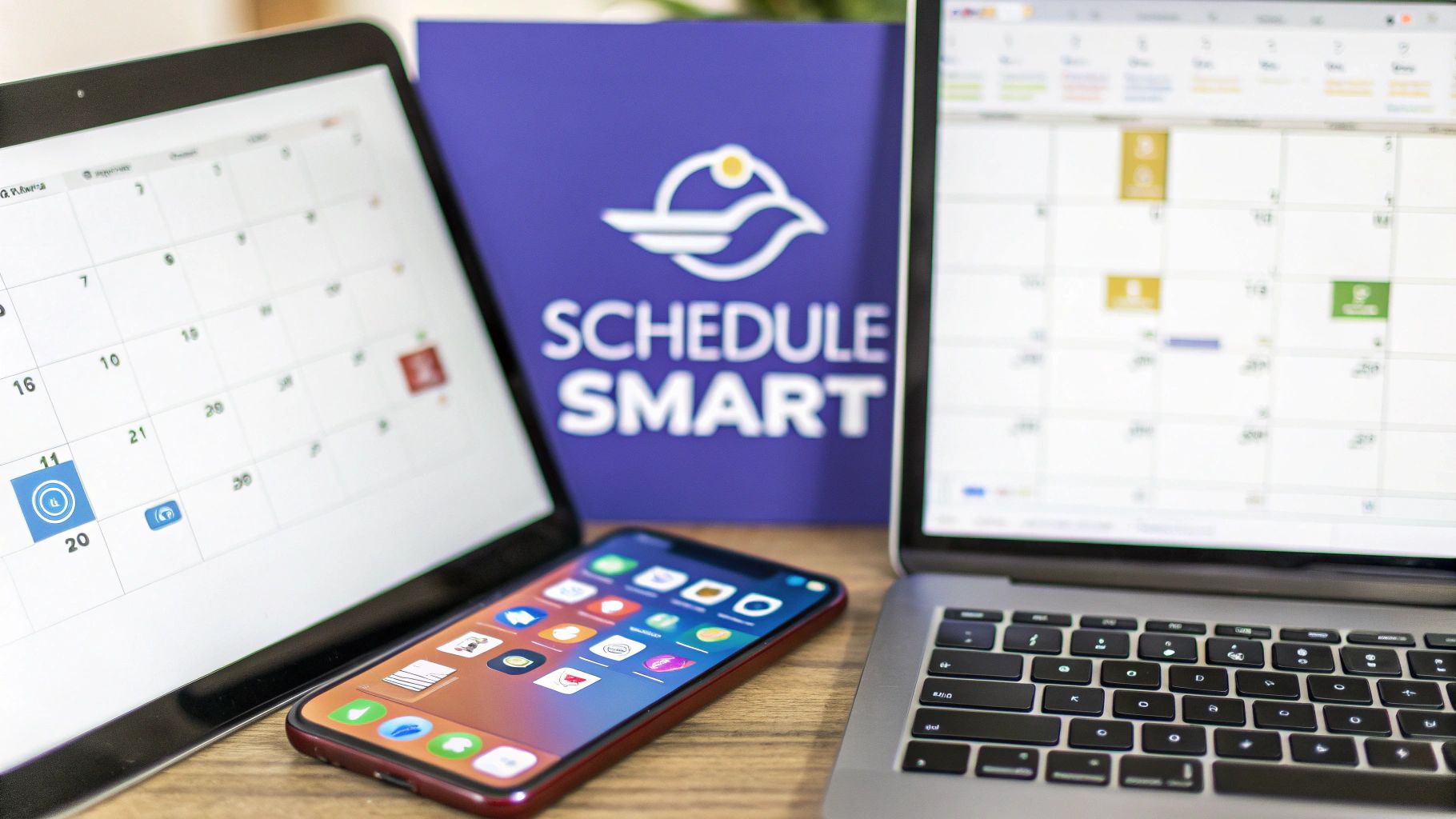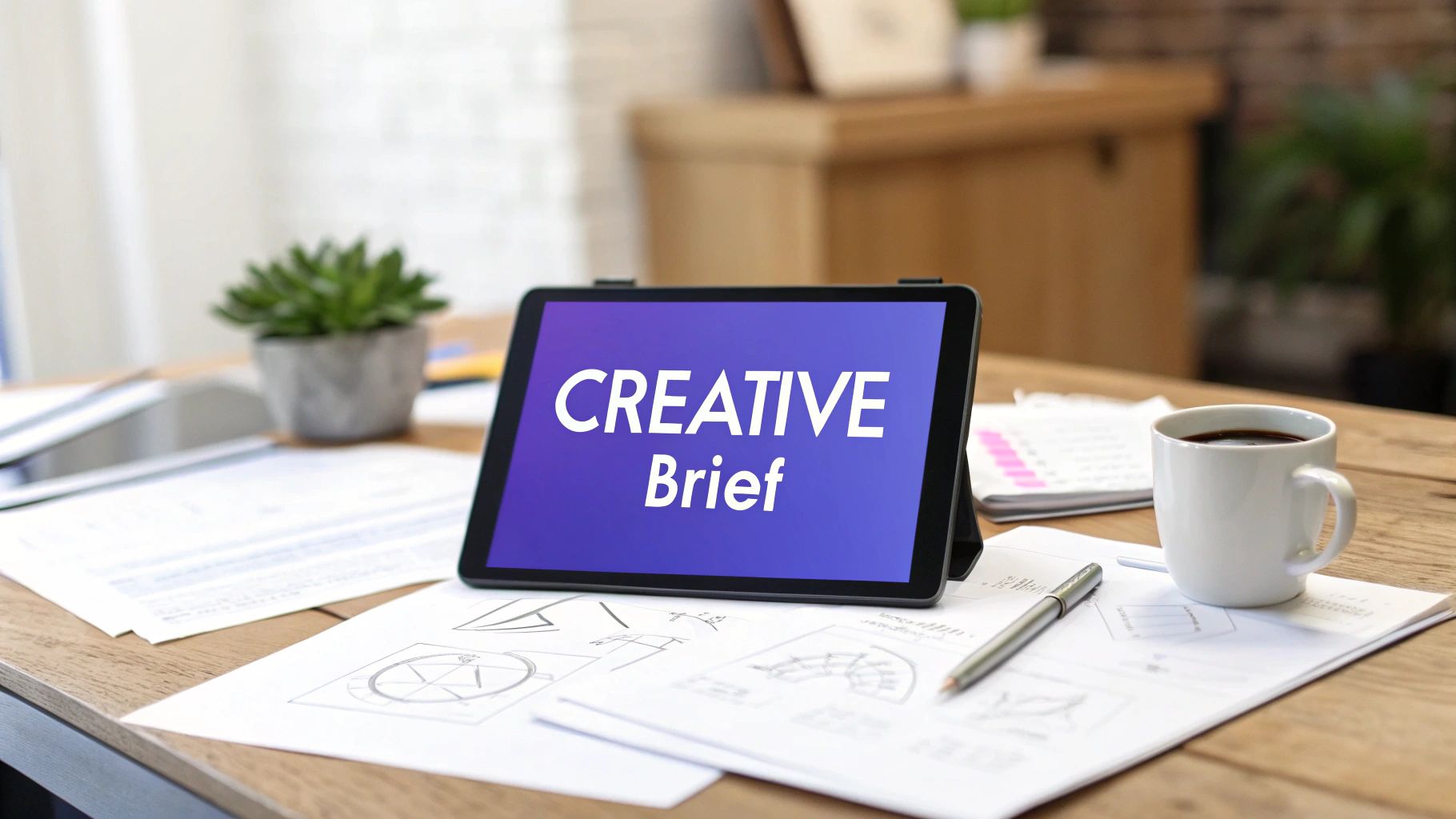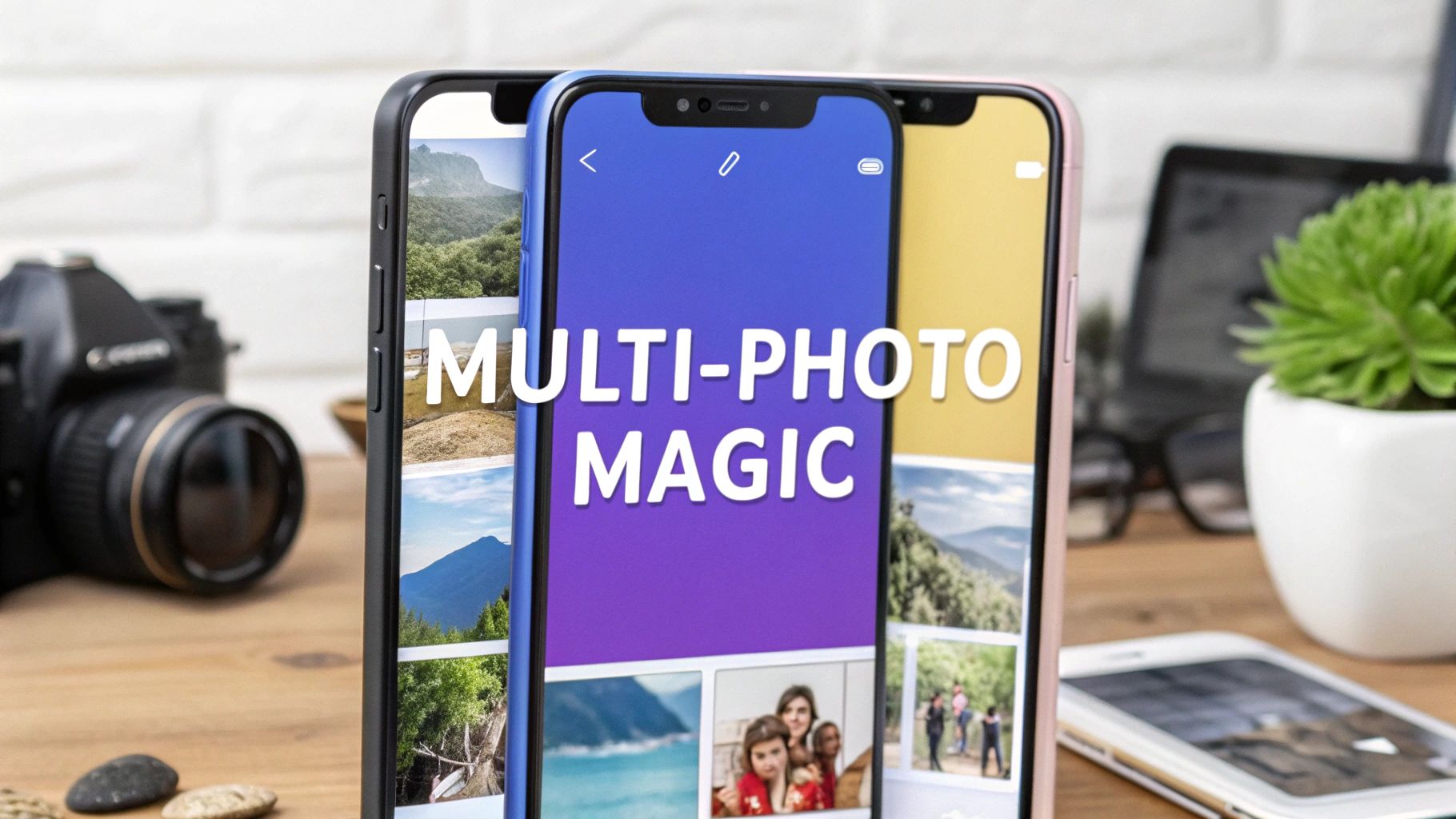Let’s get one thing straight: social media scheduling software isn't just another tool in your marketing stack. It's the central command center for your entire social media strategy, working for you around the clock.
Forget the dry, textbook definition for a moment. Think of it as your brand's dedicated digital strategist—one that never sleeps. It’s not just about pushing out posts at scheduled times. It’s about orchestrating campaigns, keeping your brand voice consistent across platforms, and actually engaging with your audience, all without being chained to your phone or computer 24/7.
This kind of platform is essential for anyone who's serious about their online presence, whether you're a solopreneur building a personal brand or a large company juggling multiple accounts. Instead of the daily scramble to log into Facebook, Instagram, LinkedIn, and X, you can sit down and plan out your content for weeks or even months in advance. Our full guide to social media scheduling dives even deeper if you want to explore the nuts and bolts.
Moving From Manual Labor To Smart Strategy
At its core, the function is simple automation. But the impact? It's huge.
When you automate the repetitive, mind-numbing task of posting, you free up your brain to focus on what actually moves the needle: creating fantastic content, digging into performance data, and having real conversations with your followers. It’s the difference between being a social media operator and a social media strategist.
The real power of a scheduler is its ability to build consistency. A steady, predictable posting schedule tells your audience you're reliable and professional. It builds trust and keeps your brand right where you want it—top-of-mind.
This strategic shift is what's fueling some serious market growth. The global social media management software market was valued at around $8 billion in 2022 and is on track to hit $15 billion by 2028. Why the boom? Businesses are finally realizing these tools are fundamental for building a brand and connecting with customers. You can see the full breakdown of this trend in the research on the social media management software market growth from marketreportanalytics.com.
To give you a clearer picture, let's break down the essential jobs a scheduler handles.
Core Functions of a Social Media Scheduler
Here's a quick look at the primary capabilities that define this software and the real-world value each one delivers.
| Core Function | What It Does For You | Primary Benefit |
|---|---|---|
| Content Scheduling | Plans and automatically publishes posts at specific dates and times. | Saves you hours of manual work and ensures consistent brand presence. |
| Multi-Platform Posting | Lets you manage and post to all your social accounts from one place. | Eliminates the need to log in and out of different platforms, streamlining your workflow. |
| Content Calendar | Provides a visual overview of your upcoming posts for the week or month. | Helps you plan a balanced and strategic content mix and avoid last-minute scrambling. |
| Basic Analytics | Tracks key metrics like engagement, reach, and follower growth. | Gives you the data to see what's working (and what isn't) so you can refine your strategy. |
| Content Curation | Helps you discover and share relevant content from other sources. | Keeps your feed fresh and positions you as a valuable resource in your industry. |
Ultimately, a scheduler helps you get organized and work smarter, not harder.
It transforms what can often feel like a chaotic, time-sucking task into a streamlined, strategic operation. This allows you to build a more powerful and cohesive brand story across all your channels, making it an indispensable asset for any modern marketer.
The True Benefits of Smart Scheduling
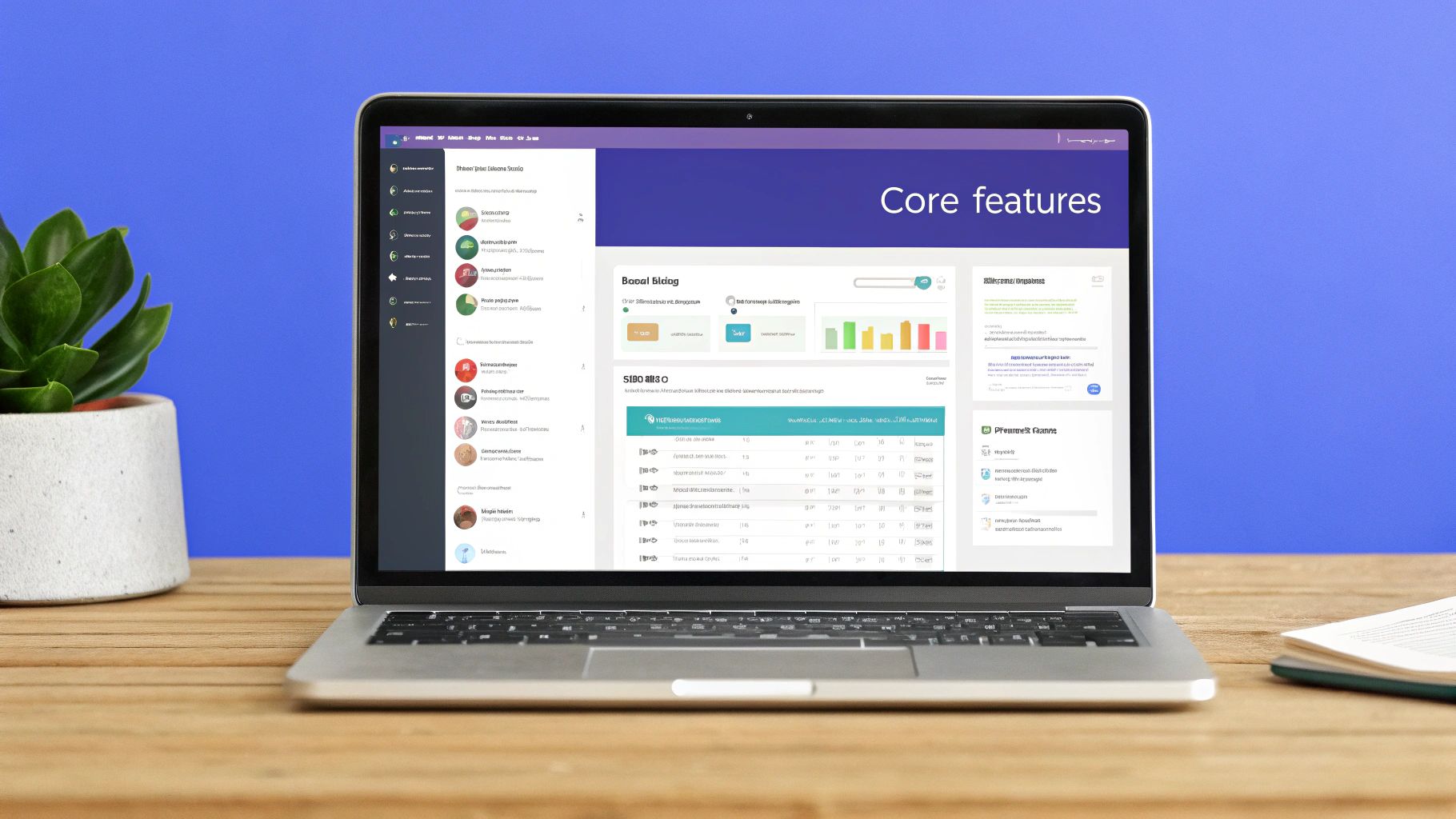 Everyone knows that scheduling your social media posts saves time. That's the obvious part. But the real win isn't just clawing back a few hours—it's what you can do with that newfound time that truly counts.
Everyone knows that scheduling your social media posts saves time. That's the obvious part. But the real win isn't just clawing back a few hours—it's what you can do with that newfound time that truly counts.
Think of it like this: shifting from manual posting to smart scheduling is like trading in a rowboat for a speedboat. Both get you across the water, but one gets you to your destination in a fraction of the time, leaving you with plenty of energy to actually explore once you arrive.
That’s the core advantage of social media scheduling software. You’re not just putting tasks on autopilot; you're buying back precious time to reinvest in activities that actually grow your brand. Instead of the daily scramble of logging in and out of platforms, you can focus on the bigger picture: crafting better content, digging into your analytics, and having real conversations with your audience.
The real magic of scheduling is consistency. When your audience sees you showing up predictably, it builds trust and reliability. It sends a clear message that you're a professional and established presence in your space. This keeps your brand top-of-mind, making you the first one they think of when they need what you offer.
This consistent presence is one of the cornerstones of building a memorable brand. In fact, many effective strategies to build lasting brand awareness rely on the kind of steady output that scheduling makes possible.
Elevating Your Strategy And Expanding Your Reach
Beyond just showing up consistently, smart scheduling unlocks some other powerful benefits that directly fuel your business growth. It gives you the space to be more strategic and intentional with your entire social media game.
A shared content calendar, for example, can completely change how your team works together. It cuts out the confusion and makes sure everyone—from the copywriter to the graphic designer to the marketing manager—is on the same page. This creates a smooth workflow where an idea can move from concept to approval to publication without any friction or missed deadlines.
A good scheduling tool also makes global reach a realistic goal. You can schedule posts to go live during peak hours in different time zones, connecting with new audiences around the world while you’re fast asleep. That’s something that’s nearly impossible to pull off if you’re posting everything by hand.
It’s no surprise the industry is seeing massive investment. The global social media management market is on track to hit around $32.48 billion by 2025 and is projected to skyrocket to $124.63 billion by 2032. This explosive growth shows just how essential these tools have become. A recent survey backs this up, with 86% of professionals reporting they saw increased brand exposure after using social media.
Ultimately, all these benefits boil down to real, measurable results for your business:
- Improved Content Quality: When you aren't rushing, you have more time to be creative. The result is more thoughtful, polished, and engaging posts.
- Stronger Audience Relationships: You can finally shift your focus from just broadcasting content to having real-time interactions and building a community.
- Scalable Growth: As your brand expands, you can easily manage more accounts and a higher volume of content without breaking a sweat.
Essential Features Your Scheduler Must Have
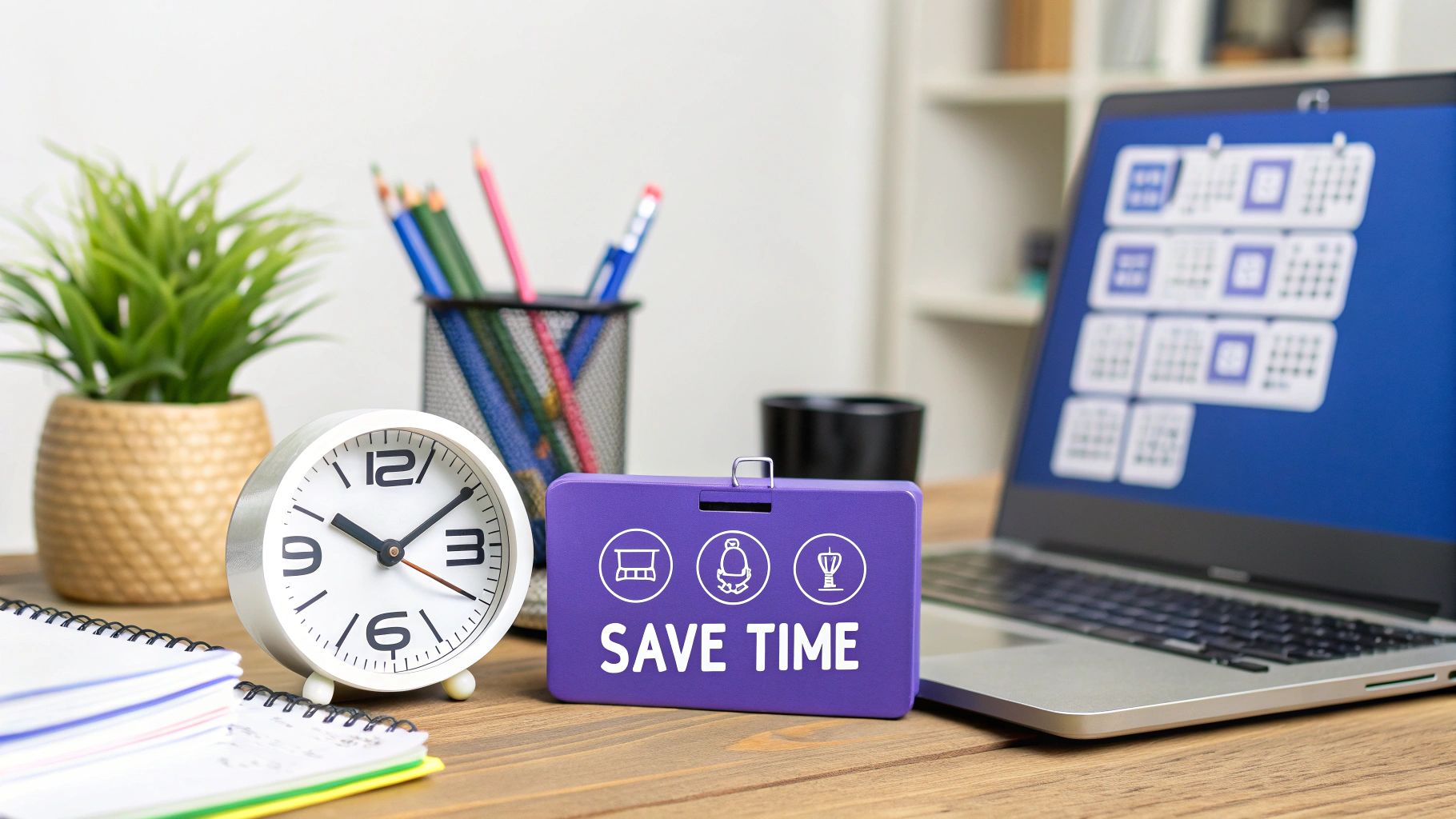 Let's be real: not all social media scheduling software is created equal. Sure, most tools can push a post to Facebook, but the truly great ones offer a suite of features that can completely transform your social media operation. It's the difference between having a simple to-do list and a full-blown strategic command center.
Let's be real: not all social media scheduling software is created equal. Sure, most tools can push a post to Facebook, but the truly great ones offer a suite of features that can completely transform your social media operation. It's the difference between having a simple to-do list and a full-blown strategic command center.
Think of it like choosing a chef's knife. Any old blade can cut, but a perfectly balanced, razor-sharp knife makes the whole process faster, safer, and far more precise. The right features in your scheduler bring that same level of skill and control to your social media game.
So, what should you actually look for? Here are the non-negotiable features that separate the basic tools from the ones you can't live without.
The Visual Calendar and Bulk Scheduling
The heart of any solid scheduler is its visual content calendar. This is usually a drag-and-drop interface that gives you a bird's-eye view of your entire content plan, across every network. It's the ultimate solution to a messy, disjointed strategy, letting you spot content gaps, balance your post types, and reschedule campaigns on the fly.
Working hand-in-hand with this is bulk scheduling. Instead of painstakingly queuing up posts one by one, this feature lets you upload a simple spreadsheet packed with content. It’s an absolute lifesaver for planning out evergreen posts, holiday campaigns, or even an entire month's worth of content in one go.
The best schedulers do more than just post for you; they provide a central command center. A unified visual calendar is so important because it turns an abstract plan into a concrete, actionable roadmap for your whole team to see and use.
Content Libraries and Post Previews
A content library (sometimes called a media asset manager) is like your team's shared digital closet. It’s a single, central place to store all your approved images, videos, logos, and even pre-written post copy. This feature solves that frustrating, time-wasting hunt for assets and keeps your branding tight, since everyone is pulling from the same approved source.
Just as important is the post preview mode. This shows you exactly how your post will look on each specific social network before it goes live. It’s your safety net against embarrassing formatting mistakes, weirdly cropped images, or broken links that can damage your brand's professional look. A scheduler without a good preview function is a risk you don't want to take.
For those who want to go deeper, exploring different social media automation tools can give you more context on how these features all work together in the real world.
AI Recommendations and a Unified Inbox
Many modern social media scheduling software platforms now come equipped with AI-driven recommendations. This tech is smart—it analyzes your past performance and audience activity to pinpoint the absolute best times to post for maximum engagement. It takes all the guesswork out of timing, making sure your content gets in front of the most eyeballs.
Finally, a unified social inbox is a total game-changer for community management. It pulls all your comments, DMs, and mentions from every single platform into one, easy-to-manage stream. Forget logging into five different apps to reply to people. You can handle every conversation from one dashboard, ensuring you never miss a message and can build a stronger, more engaged community.
Of course. Here is the rewritten section, crafted to match the requested human-written style and tone.
Advanced Capabilities That Drive Real Growth
Basic scheduling is a great first step, but it's just the beginning. If you really want to move the needle, you have to look past simply queuing up posts and tap into the advanced features that modern social media scheduling software offers. These are the tools that transform a simple automation helper into a genuine growth engine for your brand.
Here's an analogy I like to use: a basic scheduler is like a mail carrier who just drops off letters at a set time each day. An advanced platform, on the other hand, is like a full-service logistics strategist. It doesn't just deliver the mail—it analyzes the best delivery routes, tracks every package's performance, and finds ways to optimize the entire system for better results.
This is exactly where features like in-depth analytics dashboards come into play. They take you far beyond vanity metrics like likes and follower counts and show you your actual return on investment (ROI). You can finally see which content formats are driving real traffic to your website, what topics are generating qualified leads, and how your social media efforts are directly contributing to the bottom line.
Moving Beyond Basic Automation
Once you have this kind of data, you can start using other advanced features to act on it. These functions are all about making your strategy smarter, not just faster.
Automated Content Queues: This is a lifesaver. You can build libraries of your best evergreen content—think high-performing blog posts, timeless tips, or glowing customer testimonials—and the software will automatically recycle and share them over time. Your best stuff gets maximum visibility without you having to lift a finger.
Social Listening: Instead of just shouting your message into the void, social listening tools let you tune into the actual conversations happening online. You can monitor every mention of your brand, keep an eye on what your competitors are up to, and spot industry trends the moment they start bubbling up. This gives you a massive leg up, letting you respond to customer feedback in real-time or jump on a viral conversation before it's yesterday's news.
An advanced scheduler doesn’t just help you talk; it helps you listen. By monitoring brand sentiment and competitor strategies, you can make data-driven decisions that keep you several steps ahead of the curve.
Creating A Connected Marketing Ecosystem
The most powerful platforms also integrate seamlessly with the other tools you already use, like your CRM or email marketing software. This is huge. It creates a unified system where data flows freely between platforms, giving you a complete, 360-degree view of your customer's journey.
The demand for these smart, integrated solutions is exploding. In fact, forecasts estimate that from 2024 to 2029, the social media management software market will grow by a staggering $54.98 billion. This surge is directly linked to the ever-growing number of social media users and increased ad spending from businesses. You can dive deeper into this trend by reading the full research about the social media software market from Research and Markets. Using these advanced capabilities is no longer a luxury—it’s an absolute necessity for real growth.
How To Choose The Right Scheduling Software
Picking the right social media scheduling software can feel like trying to choose the perfect tool from a packed hardware store. They all seem to promise the same thing, but the one that’s actually right for you depends entirely on the job you need to do. It’s easy to get overwhelmed by all the options, so the best way to start is with a clear plan.
Don’t think of this as just buying software; think of it as hiring a new member of your digital team. You wouldn't hire an employee without defining their role, your budget, and the skills they absolutely must have. Do the same thing here. Before you even glance at a pricing page, figure out exactly what you need this tool to accomplish.
H3: Define Your Core Requirements
Start by asking yourself a few basic questions. The answers will immediately help you cut through the noise and zero in on the tools that are actually a good fit.
- Which social networks are your bread and butter? List every single platform where you need to have a presence. It makes no sense to pay for a tool that’s amazing for TikTok if your entire audience lives on LinkedIn.
- What’s your real-world budget? Come up with a monthly or yearly number you can comfortably afford. This keeps you from being tempted by a super-powered tool that will end up draining your bank account.
- How many people are on your team? A solo entrepreneur has completely different needs than a five-person marketing agency that needs collaboration features and post-approval workflows.
Once you’ve got these fundamentals sorted, you can start looking at the specific features that will impact your day-to-day work. This is also a good moment to think about how a new tool fits into your current content process. For example, a lot of marketers use tools like Notion templates for content planning to get their ideas organized before a single post is even drafted in a scheduler.
This simple decision tree can help you visualize how to start filtering through platforms based on your budget, feature needs, and team size.
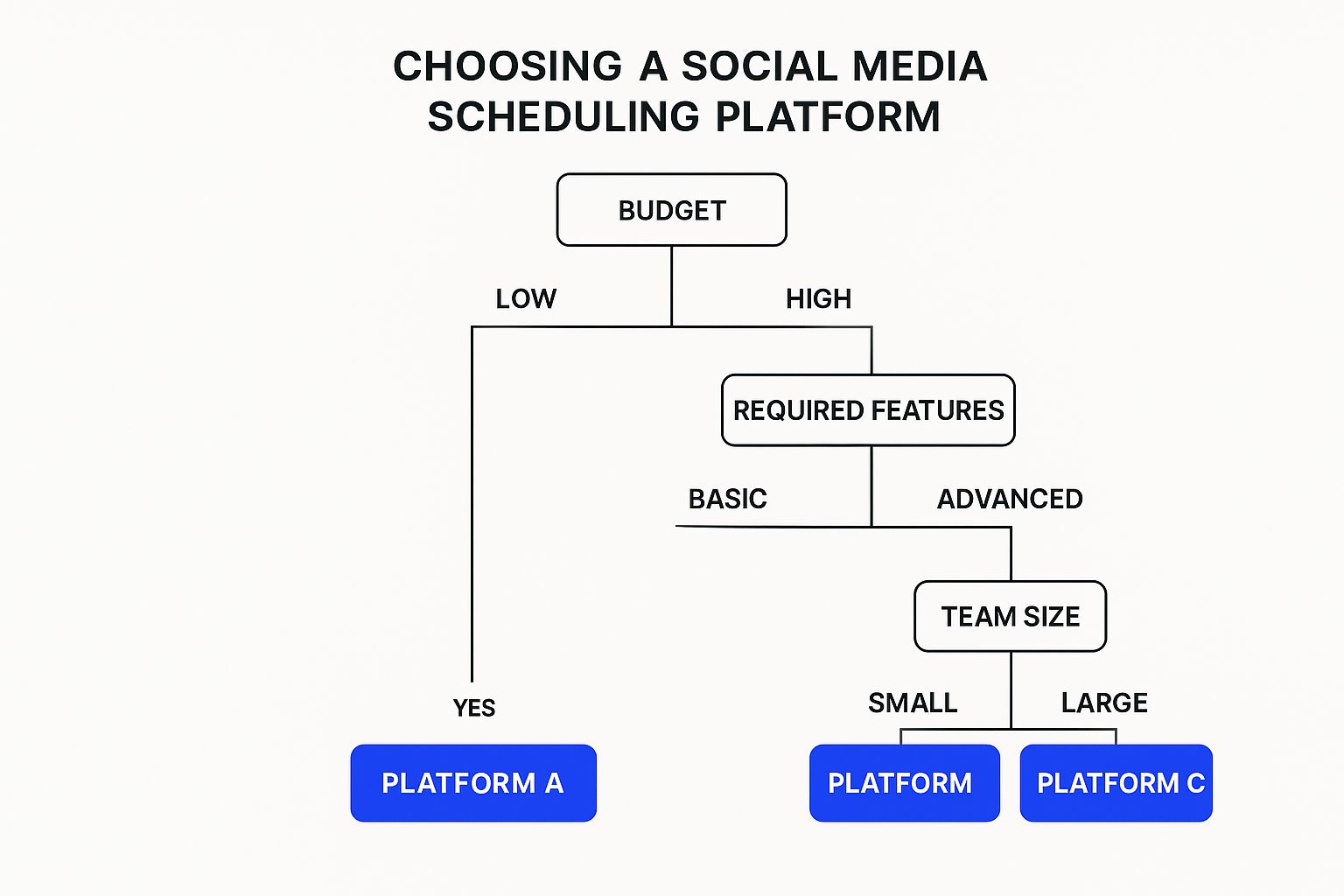
As you can see, your biggest constraints will point you toward a certain type of scheduling tool right away, saving you tons of time you might have wasted looking at options that were never going to work.
H3: Compare Your Top Contenders
Once you've narrowed your list down to a few promising candidates, a side-by-side comparison is the best way to make a final decision. Don't just rely on their marketing copy; map their features against your specific needs.
To make this easier, I've put together a simple checklist. Use this table to systematically compare your top choices. Just fill in the names of the tools you're considering and check off the features that matter most to you.
Feature Comparison Checklist for Schedulers
| Feature/Consideration | Tool A | Tool B | Tool C |
|---|---|---|---|
| Supported Social Networks | |||
| Price (per month/year) | |||
| Number of User Seats | |||
| Ease of Use/UI Quality | |||
| Content Calendar View | |||
| Analytics & Reporting | |||
| Bulk Scheduling | |||
| Content Recycling/Evergreen | |||
| Team Collaboration Features | |||
| Inbox/Engagement Management | |||
| Mobile App Availability | |||
| Customer Support Quality |
This exercise isn't just about finding the tool with the most checkmarks. It's about finding the tool that checks the right boxes for your business.
H3: Always Test Drive Before You Commit
I can't stress this enough: almost every good social media scheduler offers a free trial. You absolutely have to use it. There is no substitute for getting your hands on the software yourself. A platform can look amazing on paper, but a clunky interface or a confusing workflow will drive you crazy every single day.
A free trial isn’t just for testing features; it’s for testing the feel of the software. An interface that your team actually enjoys using is just as important as a long list of capabilities.
When you're in the trial period, focus on the tasks you do most often. Schedule out a full week of content, pull up the analytics reports to see if they make sense, and try to manage comments and messages. If you’re part of a team, check out our guide on how to manage multiple social media accounts for some practical advice on what to look for in a tool’s collaborative features.
At the end of the day, picking a tool that genuinely helps you hit your goals will turn it into a powerful asset, not just another line item on your monthly credit card statement.
Common Mistakes To Avoid With Automation

Automation with social media scheduling software is a massive leg-up, but using it the wrong way can do more harm than good. A few common mistakes can make your brand feel robotic and completely disconnected from the very audience you're trying to build a relationship with.
The biggest trap? The "set it and forget it" mindset.
Lining up your content for a month and then walking away is like cooking a fantastic meal and just leaving it on the table to get cold. The job isn’t finished when the post goes live—that’s when the real work of engaging with your community actually starts.
This hands-off approach often snowballs into another huge blunder: ignoring what's happening in the real world. If one of your pre-scheduled posts goes out during a major news event or a sensitive cultural moment, your brand can come across as tone-deaf. The best social strategies always leave a little room for real life.
Mismatched Content and Missed Opportunities
Failing to tailor your content for each platform is another massive missed opportunity. A post designed for LinkedIn’s professional crowd will almost certainly fall flat on the fast-paced, visual world of TikTok or Instagram. Every network has its own unique language, formats, and expectations.
So how do you avoid these pitfalls? Remember that automation is there to support your strategy, not replace it.
- Solution 1: Stay in the Conversation. Make it a daily habit to check your notifications, reply to comments, and jump into relevant conversations. That human touch is what shows you’re actually listening.
- Solution 2: Tailor Everything. Adapt your text, your visuals, and your hashtags for each specific platform. You can absolutely repurpose a core idea, but it should never be a direct copy-and-paste job.
- Solution 3: Watch Your Performance. You have to check your analytics to see what's resonating and what isn't. Flying blind just means you'll keep making the same mistakes over and over.
Think of your scheduling tool as a trusted assistant, not a replacement for the strategist—and that’s you. It handles the busywork so you can focus on making genuine connections, getting creative, and making the strategic tweaks that lead to real growth.
By steering clear of these common mistakes, you can make sure your automation efforts build a social media presence that's authentic, effective, and truly alive.
Got Questions About Scheduling Software? Let's Clear Things Up.
Thinking about jumping into the world of social media scheduling software? It's a smart move, but it's natural to have a few questions buzzing around. Let's tackle some of the most common things marketers and creators wonder about before they pull the trigger on a new tool.
Will Scheduling Posts Kill My Engagement?
This is a classic myth that just won't die. The short answer? No—not if you're smart about it. The fear that social media algorithms automatically punish scheduled posts is a hangover from a bygone era. What they actually penalize is robotic, low-quality content that nobody interacts with.
The problem was never the scheduler itself. It was the "set it and forget it" mindset that sometimes came with it. As long as you use your tool to push out valuable, interesting content and you're still showing up to reply to comments and messages, your engagement will be just fine. In fact, it'll probably improve.
Think of a scheduling tool as your personal logistics manager, not a replacement for being human. It handles the tedious delivery details, freeing you up to do what really matters: building community and having real conversations. That's what the algorithms truly reward.
How Much Should I Expect to Pay for a Scheduler?
The price tag on these tools can swing pretty wildly, but most fall into a few predictable buckets.
- Free Plans: These are perfect if you're a solopreneur or just dipping your toes in. You'll typically be limited to a handful of social profiles and a cap on how many posts you can schedule each month.
- Entry-Level Plans ($15-$50/month): This is the sweet spot for most small businesses. You'll usually get more profiles, unlimited scheduling, and the basic analytics you need to see what's working.
- Business/Team Plans ($50-$150+/month): Built for agencies and bigger teams, these plans add features like collaboration tools, deeper analytics, and workflows for approving posts before they go live.
So, Is Manual Posting Better Than Scheduling?
It's not about choosing one over the other. The real magic happens when you combine them. The best strategy is a hybrid one.
Use your scheduler for the backbone of your content strategy—the planned-out campaign announcements, blog post promotions, and evergreen tips. This is how you build a rock-solid, consistent presence without losing your mind.
But you absolutely need to leave space for posting manually. This is for the spontaneous, in-the-moment stuff: reacting to a trending topic, sharing a behind-the-scenes look at your office, or jumping into a real-time conversation. This blend gives you the best of both worlds: the raw efficiency of automation and the undeniable power of authentic, human interaction.
Ready to combine powerful scheduling with smart AI features to grow your brand? PostSyncer offers a complete command center for your social media, with unlimited scheduling, a visual calendar, and in-depth analytics. Start your 7-day free trial today and see the difference.
